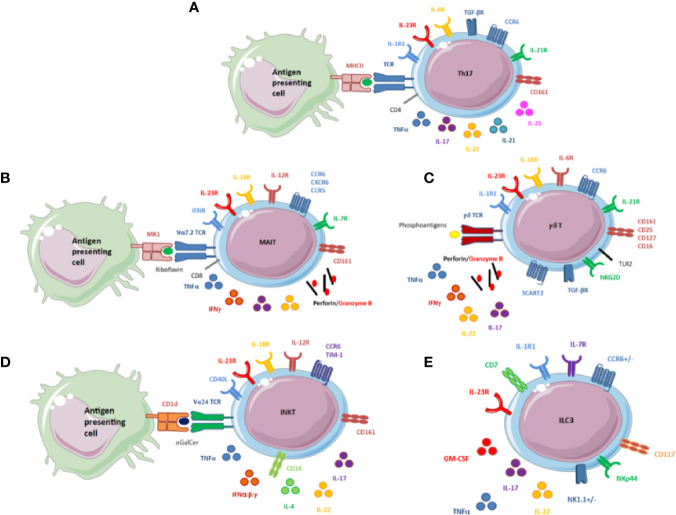Figure 2.
(A) Schematic overview of the main receptors and secreted cytokines of Th17 cells. CD4+Th17 cells are induced on T-cell receptor (TCR) activation in the presence of TGFβ, IL-1β, IL-6, IL-21, and IL-23. IL-6, IL-21, and IL-23 activate STAT3, which binds to the promoter regions and activates transcription of RORγt and IL-17. Th17 cells also produce other cytokines, mainly pro-inflammatory cytokines: TNFα, IL-21, IL-22, and IL-26. Th17 cells possess 2 markers specific to IL-17 producing cells: CD161, a marker of activation belonging to the C-lectin family, and CCR6, a chemokine receptor that binds only one chemokine, CCL20. It may regulate the migration and recruitment of dendritic cells and T cells during inflammatory and immunological responses. (B) Schematic overview of the main receptors and secreted cytokines of mucosal-associated invariant T (MAIT) cells. MAIT cells express an invariant TCR, Vα7.2. They recognize the conserved major histocompatibility complex-like protein 1 (MR1), which presents a bacterial-derived ligand, riboflavin. MAIT cells express various cytokines and receptors. In the cytokine environment, MAIT cells can release cytotoxicity granules, perforin and granzyme (B) They also display specific receptors to induce a type 1 immune response (IFN, IL-12, and IL-18 receptors to produce TNFα and IFNγ) and a type 3 immune response (IL-23R to produce IL-17 and IL-22). IL-7 receptor (IL-7R) is also displayed on the surface of MAIT cells. IL-7R plays a critical role in the development of immune cells and could be of particular interest for these cells. MAIT cells possess the 2 markers specific to IL-17–producing cells, CD161 and CCR6. CXCR6 and CCR5 are also expressed, but their roles are not fully understood. (C) Schematic overview of the main receptors and secreted cytokines of γδ T cells. γδ T cells express a TCR that does not engage major histocompatibility complex antigen complexes but rather conserved phosphoantigens of bacterial metabolic pathways. Self-induced proteins overexpressed by infected cells or tumor cells are detected by NKG2D expressed at the surface of γδ T cells. IL-1, IL6, IL-18, IL-23R, and TGFβ induce the production of IL-17. TLR2 is expressed at the surface of these cells and could also be involved in the production of IL-17 by γδ T cells. γδ T cells can also release cytotoxicity granules: perforin and granzyme B and other pro-inflammatory cytokines, IL-22, TNFα, and IFNγ. IL-7 receptor (IL-7R) is on the surface of γδ T cells and participates with CD25 and SCART2 in maintenance of the phenotype. γδ T cells possess the 2 markers specific to IL-17–producing cells, CD161 and CCR6. (D) Schematic overview of the main receptors and secreted cytokines of invariant natural killer T (iNKT) cells. iNKT cell activation depends on the interaction between the invariant TCR antigen Vα24 with CD1d loaded with the prototypic antigen glycosphingolipid a-galactosylceramide (αGalcer). iNKT cells can also be activated independently by the cytokine environment. iNKT cells display different receptors: “type 1”: IL-12 and IL-18 receptors”; type 3”: IL-23 receptor; but also CD40L to interact with B cells. This combination allows for releasing various cytokines including TNFα, IFNα, IFNβ, IFNγ, IL-4, IL-17, and IL-22. iNKT cells also possess 2 markers specific to IL-17–producing cells, CD161 and CCR6. (E) Schematic overview of the main receptors and secreted cytokines of innate lymphoid cells (ILCs). ILCs are characterized by lack of markers specific for T cells, B cells, and other hematopoietic cells. ILC development depends mainly on IL-7. ILCs are tissue-resident cells and possess chemokine receptors for migration, CCR6 for ILC3. ILC3s are related to RORγT and produce IL-17, IL-22, TNFα, and granulocyte macrophage–colony-stimulating factor in response to IL-1β and IL-23. Human ILC3s are identified by the combination of NKp44 that may normally contribute to the increased efficiency of activated natural killer (NK) cells; CD117, a tyrosine kinase receptor, and CD127 (IL-7Rα).

